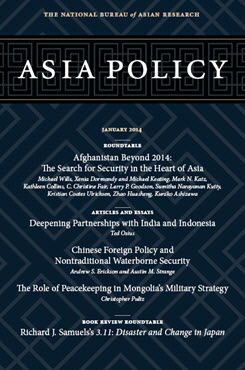The Limits of Cooperation
Central Asia, Afghanistan, and the New Silk Road
This is one of nine essays in the roundtable “Afghanistan Beyond 2014: The Search for Security in the Heart of Asia.”
In anticipating the United States’ ultimate withdrawal from Afghanistan, the Obama administration has sought to enlist Afghanistan’s northern neighbors within Central Asia in an effort to stabilize and invigorate the region politically and economically. In 2011 the administration proposed a “new Silk Road” initiative linking the world to Afghanistan. The strategy is to enlist the country’s Central Asian neighbors in a win-win scenario that will spur trade, energy exports, investment, and peace. The former Soviet “stan” countries, proposes the administration, will be the drivers of the new Silk Road and thereby enrich themselves while uplifting Afghanistan and ensuring regional stability. This vision is a hopeful one, yet the Central Asian states remain unpersuaded. Instead, they have preferred to paint a dark scenario of a coming Afghan “spillover”—of conflict and refugees, Islamist extremism and terrorism, and drugs—spreading not just to Pakistan and Iran but also northward to the former Soviet sphere and undermining the fragile stability of the post-Soviet stans.
The new Silk Road initiative is presaged on multiple faulty assumptions about Central Asian interests: first, that Afghanistan and Central Asia constitute a natural region sharing a common ethnic, religious, and historical identity, and that this identity will undergird a strong regional relationship; second, that the Central Asian states will not primarily treat Afghanistan as a security threat after the U.S. withdrawal; third, that they have shared economic interests in cooperation in Afghanistan; and fourth, that such economic opportunities in Afghanistan will trump the actions and interests of Russia and China. Each of the above assumptions is extremely problematic. The post-Soviet stans are unlikely to be reliable partners in the U.S. plan for Afghanistan after the withdrawal in 2014. In reality, regime survival, border security, and concrete economic incentives—coming from China, not Afghanistan—will determine the foreign policies of the Central Asian states.
In this essay, I first provide a realistic assessment of security threats from Afghanistan. Then I shift to an explanation of how Central Asian states’ insecurities will nonetheless undermine a new Silk Road by increasing their cooperation with Russia and decreasing integration with Afghanistan. Next, I demonstrate that economic incentives from Russia and China are directing the Central Asian states to the north and east, undercutting trade and energy routes through Afghanistan. Finally, I discuss the political and religious crackdowns likely to be justified in terms of the Afghan threat.
Afghanistan as Threat: Rhetoric and Reality
The Central Asian and Afghan populations do not share an identity despite their Silk Road roots and common religion. Soviet modernization policies set most Central Asian Muslims on a very different path, making them accepting of secular government and suspicious of the Islamic-leaning regimes of Afghanistan and Pakistan. Likewise, being Muslim and Central Asian, and sharing a Soviet legacy of both colonization and development, has not facilitated a sense of shared identity, much less cooperation, among the Central Asian states themselves. Since 1991, multiple external attempts at regional integration have either failed or remained hollow shells of international agreements. [1]
Mistrust among Central Asian leaders has often led these countries to the brink of armed conflict on their interstate borders and rarely fostered cooperation. The Central Asian republics—with the exception of the enigmatic Turkmenistan—view Afghanistan primarily as a source of instability, refugees, Islamist militancy, and narco-trafficking. Their fears for their security are not unfounded; the U.S. withdrawal is very likely to lead to an escalation of conflict within Afghanistan and potentially even to the collapse of the Karzai regime. Yet although there will be some spillover effects, the anticipated “descent into chaos,” to borrow Ahmed Rashid’s term for the Afghanistan-Pakistan trajectory, is unlikely to dramatically affect the post-Soviet stans. [2] Nonetheless, several Central Asian regimes, following Russia’s lead, have chosen to act as if that chaos is coming, both to ensure their security and to appease Moscow.
First, not only the Central Asian states and Russia but also the United Nations High Commissioner for Refugees have urged planning for a refugee…
[1] Kathleen Collins, “Economic and Security Regionalism among Patrimonial Authoritarian Regimes: The Case of Central Asia,” Europe-Asia Studies 61, no. 2 (2009): 249–81.
[2] Ahmed Rashid, Descent into Chaos: The U.S. and the Failure of Nation Building in Pakistan, Afghanistan, and Central Asia (New York: Viking, 2008).
About Asia Policy
Asia Policy is a peer-reviewed scholarly journal presenting policy-relevant academic research on the Asia-Pacific that draws clear and concise conclusions useful to today’s policymakers. Asia Policy is published quarterly in January, April, July, and October and accepts submissions on a rolling basis. Learn more


